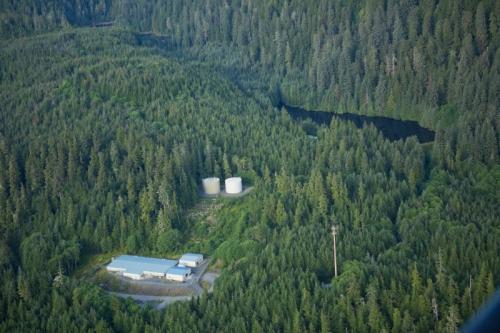
This article is part of a series. Read part two here. Read part three here. Read part four here.
Wrangell’s water system seasonally struggles to effectively clean water and keep up with the community’s water demands.
This first installment of a multi-part series on Wrangell’s water woes covers how problems with the island’s open-water reservoirs are among many challenges facing the community’s water system.
These days, Wrangell’s Senior Center is a quiet place. Blue indoor-outdoor carpeting, sturdy wooden chairs with armrests, and circular tables sit largely unused as communal meals and events have been on hold since the onset of the COVID-19 pandemic.
The center still delivers food and drinks, though, and key to the operation is the water filter, tucked out of sight under the sink. Coire Johnson says he recently learned of Wrangell’s struggles to meet state water quality standards.
“Since I heard about that,” Johnson explained, “we strictly have gone to anything that’s going out our door and going into somebody’s mouth, it’s filtered water. And then the rest of it we just use for cleaning.”
Wrangell’s water isn’t exactly dangerous to drink. But long-term it can cause health issues, especially for vulnerable populations like the elderly, children and pregnant women.
With all that in mind, Johnson says his senior patrons have questions.
“Some of the customers that come by and we would give them coffee, they commented on it: ‘Hey, is this filtered?’ And I guess it may have been half-hearted and joking, but probably not.”
Wrangell has issues with its city water. To many Wrangellites, that’s not breaking news. But in this series, we’re trying to trace exactly why those issues exist, from source to tap.
The water reservoirs are full of sediment. A patchwork of leaky pipes do a poor job of circulating water from the lake to the filtration plant… all before the cleaning process even begins. And then there are problems with how the plant cleans.
If you boil it down, the water issues are caused by a few intertwined problems. Each taken alone, they might not be a big deal. But when combined, the speedbumps at every point of the process make for constricted water flow and water that’s pretty consistently in violation of state water quality standards.
Wrangell’s mayor, Steve Prysunka, remembers a time before the water plant: “When I first moved here, you’d pour a bath and it looked like you were taking a bath in tea.”
The tea-colored tap water situation has improved since the 1990s, since Wrangell got its current water plant. But Prysunka can list off problems in supply and distribution for minutes on end, from the creek that flows into the reservoirs, to the reservoirs themselves…
“The dams are the second-worst dams in the entire state,” Prysunka continues.
That’s not his opinion. The Alaska Department of Natural Resources wrote as much in a 2015 report. The earthen dams are unstable, and susceptible to failure if there’s an earthquake. Seemingly everything is a problem. We’ll start at the top of this gravity-fed system.
Wrangell gets its water from a creek, diverted into two open reservoirs on a hill above its water plant. They’re old: from the 1950s. Plant operator Wayne McHolland says that means a huge amount of sediment over time. I spoke with him at the water plant, which is pretty loud, even in the office.
“We tested the organic loading on the creek. And it was, hell, it wasn’t half the organic loading in the reservoir.”
In other words, Wrangell’s source water actually gets dirtier as it enters the system.
Organic loading is everything that collects in the water: leaves, branches, dead fish. There’s bound to be some. The water flows down from muskeg, so there’s going to be bits of plant matter no matter what. But the years of buildup in the reservoirs exponentially compound the problem.
And then there’s the reservoir’s pipes. The link between the two reservoirs is damaged, and the plant can’t draw water out the way it used to.
“There’s a bypass line that we didn’t quite get done through the upper reservoir to tie the two together — plus operate the plant on one or the other for maintenance purposes or whatnot,” McHolland adds.
The bypass would allow the plant to link up to the upper reservoir, allowing plant workers to do maintenance or maybe some cleaning. At the moment, that’s not possible.
A $2.5 million project to bypass the lower reservoir is still in the planning stages and is third on the list of funding priorities for Wrangell in the coming year.
The city estimates that stabilizing and improving the dams and reservoirs — a separate project — would cost around $50 million.
“We could have built a reverse osmosis plant and drawn water out of the ocean for probably $25 million. So cleaning the reservoirs would have been a moot point,” McHolland laughs.
To recap, Wrangell has ageing reservoirs. The pipes are old and damaged, which means that a lot more organic matter gets into the water supply than in the past.
But isn’t cleaning out the gunk what a filtration plant is supposed to do?
In theory, yes. But a few key elements of Wrangell’s water plant were designed upside down. We’ll get to that in the next installment of our series.
Get in touch with KSTK at news@kstk.org or (907) 874-2345.











